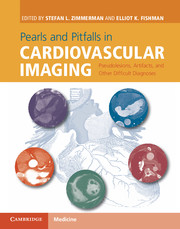 Pearls and Pitfalls in Cardiovascular Imaging
Pearls and Pitfalls in Cardiovascular Imaging from Section 1 - Cardiac pseudotumors and other challenging diagnoses
Published online by Cambridge University Press: 05 June 2015
Imaging description
Non-compaction of the ventricular myocardium is a rare congenital cardiac disease characterized by excessive myocardial trabeculations and deep intertrabecular recesses. Non- compaction is thought to be the result of the arrest of normal cardiac development in utero during the 5th to 8th week of life, a time when loose myocardial fibers in the ventricles become organized and “compacted.” [1] Non-compaction has been most often described in the left ventricle, but biventricular and isolated right ventricular involvement has also been reported. The most common locations for non-compaction are the left ventricular apex, lateral wall, and inferior wall (Figure 10.1). Diagnostic criteria have been proposed for echocardiography that rely upon a comparison of the thickness of trabeculated and compacted myocardium, or the number of prominent trabeculations. By MRI, non-compaction has been defined as a ratio of trabeculated to compacted myocardium of greater than 2.3 in end-diastole. However, recent studies in both normal subjects and patients with heart failure have suggested that current MRI criteria may be overly sensitive, resulting in overdiagnosis. Patients with non-compaction cardiomyopathy will often have myocardial dysfunction manifested by reduced ventricular ejection fraction and cavity dilation, sometimes complicated by intracavitary thrombus (Figure 10.2), which may aid in diagnosis. On dark blood images, high signal may be seen in between the prominent trabeculations due to slow blood flow. Delayed myocardial enhancement involving the prominent trabeculations may be present and has been associated with reduced ejection fraction and more advanced disease.
Importance
Accurate diagnoses of LV non-compaction is challenging due to lack of clear diagnostic test for the disease and substantial overlap of current criteria with healthy subjects and those with heart failure from different causes. True non-compaction cardiomyopathy is a serious disease with a poor prognosis. Identification of these patients is important as they have a high rate of symptomatic heart failure, thromboembolic events, ventricular arrhythmias, and sudden death. Some will eventually require heart transplant or placement of an implantable cardioverter defibrillator (ICD).
To save this book to your Kindle, first ensure [email protected] is added to your Approved Personal Document E-mail List under your Personal Document Settings on the Manage Your Content and Devices page of your Amazon account. Then enter the ‘name’ part of your Kindle email address below. Find out more about saving to your Kindle.
Note you can select to save to either the @free.kindle.com or @kindle.com variations. ‘@free.kindle.com’ emails are free but can only be saved to your device when it is connected to wi-fi. ‘@kindle.com’ emails can be delivered even when you are not connected to wi-fi, but note that service fees apply.
Find out more about the Kindle Personal Document Service.
To save content items to your account, please confirm that you agree to abide by our usage policies. If this is the first time you use this feature, you will be asked to authorise Cambridge Core to connect with your account. Find out more about saving content to Dropbox.
To save content items to your account, please confirm that you agree to abide by our usage policies. If this is the first time you use this feature, you will be asked to authorise Cambridge Core to connect with your account. Find out more about saving content to Google Drive.